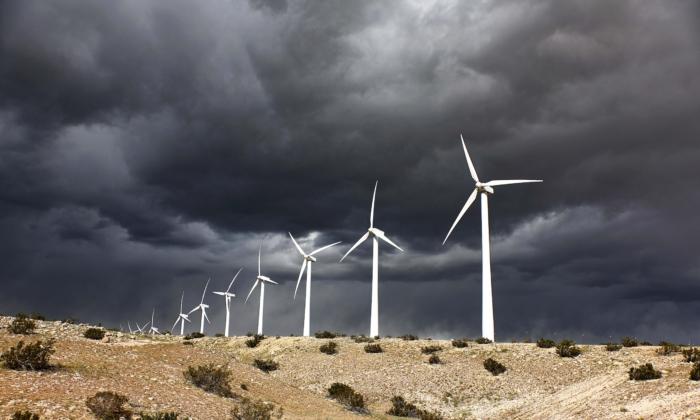Efforts to boost renewable energy have increased in recent years, with a growing number of wind farm turbines installed in California and across the country. But some scientists are raising concerns about the dangers of wind-related green energy and its inefficiency compared to traditional power sources.
Wind power generation increased more than 350 percent from 2001 to 2023 in the Golden State and now accounts for slightly more than 7 percent of all power generated in the state, according to the California Energy Commission.
Damage to ecosystems is the most noticeable impact of wind turbines, with countless numbers of birds and bats killed since the first wind farm was installed in the U.S. in New Hampshire in 1980, according to experts.
“The numbers keep going up, but it’s estimated that about 1 million birds and 1 million bats are killed by wind farms every year,” Jim Steele, biologist and director emeritus of San Francisco State University’s Sierra Nevada Field Office, told The Epoch Times.
According to Mr. Steele, some species only occasionally breed, such as turkey vultures and hawks, which only have one or two chicks per year.
“When you take them out, it’s harder for their numbers to come back,” he said.
Collisions with spinning turbines lead to many deaths of migratory birds, and predatory species—such as kestrels and hawks—are killed while trying to pursue prey on the ground. Some wind farm proponents suggest eliminating vegetation under the turbines to reduce such deaths, but critics argue the move could prove catastrophic.

“When we change the vegetation and hydrology of a landscape, we cause extinction,” Mr. Steele said.
Power lines connecting wind farm installations to power grids are also responsible for significant bird deaths due to electrocution, according to experts.
According to Mr. Steele, it’s estimated that up to 60 million birds die each year across the United States by hitting power lines—with networks expanding to access wind farms often located far from existing transmission lines, according to experts.
“There are miles and miles of lines where you'll have dead birds you’ll never see,” he said.
Interest in wind farms has grown nationwide over the past 30 years, following a tax credit issued by Congress in 1992 that facilitated financing and expedited expansion.
But some have been worried about land inefficiencies.
Such was the focus of studies conducted by scientists at Harvard University and published separately in 2018 that determined a transition to wind-derived power in the United States would require five to 20 times more acreage than researchers previously determined in a study from 2013.
The later studies found that the rate of power per acre of land generated was up to 100 times lower than previously estimated.
“All else equal, lower power densities mean larger land and environmental footprints,” the authors wrote in the study published in the Journal of Environmental Research Letters. “The power density of solar and wind power remain surprisingly uncertain.”
Critics also point to the inconsistencies with wind power production that result in wind speed variations.
When wind speeds are low, power generation is diminished, and when winds are too high, operators are forced to power down turbines to protect the mechanical components from damage that occurs when blades spin too fast. Both instances reduce the amount of power produced.

Following the installation of offshore wind turbines off the coast of Rhode Island in 2016, interest in developing wind farms off the coast of the United States has continued to grow, with several projects now planned off the coast of California.
“The political enthusiasm and the investor hype are not supported by the evidence, even for offshore wind, which can be deployed out of sight,” Wade Allison, emeritus professor of physics at the University of Oxford, wrote in a 2023 report for the Global Warming Policy Foundation titled “The Inadequacy of Wind Power.” “The wind blows somewhat more steadily offshore than onshore, as every sailor knows. Nevertheless, the unreliability inherent in wind energy persists.”
California has three main passes where winds are funneled through and amplified, and six regions produce the majority of wind power in the state, including Altamont, East San Diego County, Pacheco, Solano, San Gorgonio, and Tehachapi.
As the state is planning offshore wind farms totaling 370,000 acres by 2045, with enough generating capacity to power 25 million homes—equivalent to half the capacity generated today by all forms of power in the state—experts say they’re concerned about the sheer size of the installations and new technologies being tested in volatile locations.
The U.S. government auctioned off two offshore development sites in December 2022, located nearly 25 miles from the coast in Humboldt and Morro bays, to help the state’s offshore wind farm expansion efforts. Three companies won rights to develop in Morro Bay—Invenergy California Offshore, Central California Offshore Wind, and Equinor Wind US—and two developers, RWE and Vineyard Offshore, obtained leases in Humboldt.
Current plans are to utilize floating platforms at the locations that critics suggest are both speculative and costly to install, operate, and repair.
But as the continental shelf drops precipitously a few miles off the California coastline, dropping as much as 4,300 feet in Humboldt and Morro bays—with anything deeper than 200 feet problematic, according to experts—development of offshore wind farms is difficult and cost-prohibitive and continue to hurt some animal species.
“Wind turbines offshore probably worries me even more because I’ve watched these massive migrations where more than 300,000 birds migrated by in less than half an hour near Pacifica, California,” Mr. Steele said, referencing the small coastal town near San Francisco.
As many birds traverse the California coast on annual migratory routes, experts fear the new installations will wreak havoc on their populations.

“Pelicans and tons of seabirds going from South America and Central America to the Tundra that are in tremendous danger,” Mr. Steele said. “In the ocean, deaths are probably next to impossible to track. Even on land, observers miss a lot, and the numbers are underestimated because they’re difficult to produce.”
Incidents involving beached whales near offshore wind farm installations on the East Coast earlier this year prompted inquiries into whether audio frequencies from the turbines could be interfering with sensitive sonar communications of some sea creatures.
But experts say more research is needed to understand what, if any, connections exist between the deaths and the offshore farms.
With private enterprise and government agendas aligning to expand wind farms, critics suggest that the move comes at a cost to the environment, and some say they aren’t happy about how the money is spent.
“We’re subsidizing wind farms, and that means my tax money is going to kill birds,” Mr. Steele said. “They know about the problems, but they just keep pushing it because it’s ‘clean energy,’ but it’s clean energy at a cost.”
While some say ecosystems are in danger and billions are being spent to further green agendas, scientists suggest that objective discussion is needed to realize sustainable solutions.
“People get blinded by the hope that this will be the salvation for everything, but almost everything has a dark side, and you have to have some kind of skeptical debate about is this good or bad,” Mr. Steele said. “If you challenge an idea, they see you as a denier. It’s far from that. When you shut down that debate, that’s when you’re screwing up the scientific process that guides us for a better life.”







